Cucumbers are as versatile as they are delicious, lending themselves well to pickling, eating raw in salads and even cooking.
Cucumbers (Cucumis sativus) are heat-loving vegetables best adapted to the warmest part of the year. They are members of the Cucurbitaceae family – which also includes pumpkins, courgettes and melons – and their viny plants are grown for the crunchy, immature fruit that are one of the highlights of the summer. Cucumbers are as versatile as they are delicious, lending themselves well to pickling, eating raw in salads and even cooking – Mrs Beeton, in The Book of Household Management (1861), gives recipes for frying, stewing and using them in soup.
Indoor cucumbers
Enjoy more Kitchen Garden reading in the monthly magazine.
Click here to subscribe & save.
Cucumbers are heat-loving plants and are ideally suited to the protected environment of tunnels and greenhouses. To take full advantage of the space in a greenhouse or tunnel, by far the best varieties to grow are the all-female, parthenocarpic hybrids, whose fruit are produced without pollination. Yields can be large, and the quality is superb – not only are the fruit seedless but their skin is so tender that it needs no peeling.

Slices of an all-female, parthenocarpic cucumber hybrid showing the seedless cavity and tender skin
The all-female hybrids range in length from the diminutive super-mini or snack types to the larger standard ones. Seed is expensive, and the number of seeds in a pack is always small. Despite the seed cost, however, these varieties are high-yielding and represent excellent value for money since just one or two plants will satisfy the culinary needs of most gardeners.

All-female, parthenocarpic hybrid cucumber varieties come in different sizes. The photos above show two different sizes: standard (left) and mini (right).
Starting off
For the earliest harvests cucumbers can be sown from mid to late spring. Sow the seed about 1cm deep in 9cm pots filled with fine-textured compost. Keep the temperature about 24–25ºC, ideally in a heated propagator. The traditional advice that seed must be sown on their edge is unfounded; they germinate just as well if laid flat.
Once the seedlings emerge, they need light to prevent spindly growth, and a temperature of about 21ºC during the day, slightly less at night. You may get away with lower temperatures but the propagation period will take longer. Keep the compost moist but not wet. Never water after mid-afternoon as the seedlings must go into the night completely dry; wet seedlings are susceptible to damping off diseases during cool nights. Feed the seedlings at least once, or preferably, at every watering, with a dilute feed.
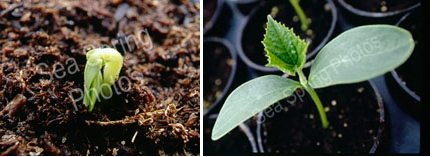
Starting cucumbers: seedling just emerging from the compost (left) and seedling with fully expanded cotyledons and one true leaf.
Transplanting
Young plants are susceptible to chilling injury, so transplanting into unheated tunnels and greenhouses should be delayed until the end of May in the south of the UK, and somewhat later further north, or at higher altitudes. The plants are ready to transplant when they have four or five fully-developed leaves, which may be four to five weeks from sowing, depending on the time of year and propagation temperature.
Indoor cucumbers should be transplanted into a well fertilised, well-drained soil of around pH 6.5, spaced 45–60cm apart. They can also be cultivated in growbags, with one or two plants per bag, or one plant per large pot of at least 15 litres in volume (30cm in diameter).
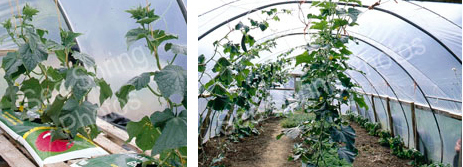
Cucumber can be raised in growbags (left) or in the ground (right).
Once plants are in place, water them regularly, but do not overwater, and be sure to ventilate well on hot days. If soil-grown plants are initially well fed they may need no further fertiliser. Those grown in containers are a different matter; they should routinely be given a dilute feed with a high potash formula two or three times a week.
Pruning and training
Like tomatoes, cucumber plants need to be trained to control growth and improve yields. Training needs a support system, which can be provided by stretching a wire horizontally about 2m above the floor in polytunnels and greenhouses. Strings should be suspended from the wire to the base of the plants, where they are secured by tying loosely to the stem base, or around the growbag.
As growth proceeds, twist the main stem of each plant around its string and initially train upwards. Plants are then trained with a combination of pruning and pinching out. Slightly different training systems are recommended according to fruit size (see table below).
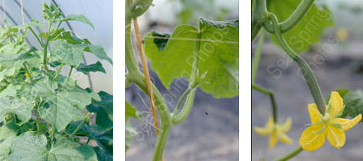
Cucumber plants pruned to a single main stem (right) supported by string twisted around the stem (middle), and one fruit per node.
In general most cucumbers should be treated like cordon tomatoes and have their sideshoots (laterals) removed. Fruit produced low down on the vines should also be removed and larger-sized fruit may need to be thinned.
Whatever the size, a cucumber is ready for harvesting when it has a uniform diameter along its whole length. Cut the stalk cleanly with a sharp knife, leaving a small piece attached to the neck of the fruit. When well-grown, it is possible to harvest plants in unheated structures from the end of June until September in much of the UK.
_____________________________________________________
Standard cucumber (more than 30cm):
Stem and lateral management:
Main stem: Allow the main stem to grow up to top wire, then pinch out the growing point.
Laterals: Remove all laterals (side shoots) on main shoot except the two nearest to the top wire. Drape these laterals over wire so that they grow downwards. Pinch out their growing tips after 5 leaves. Allow sub-laterals to develop, drape over the wire and continue as before.
Stem fruit removal:
Bottom nodes: Remove all fruit from the bottom 7 or 8 nodes of the main stem.
Remaining nodes: Remove fruit from every third node (i.e. allow two fruit to grow for every three nodes).
_____________________________________________________
Intermediate cucumbers (20-22cm)
Stem and lateral management:
Main stem: Allow the main stem to grow up to top wire, then pinch out the growing point.
Laterals: Remove all laterals (side shoots) on main shoot except the two nearest to the top wire. Drape these laterals over wire so that they grow downwards. Pinch out their growing tips after 5 leaves. Allow sub-laterals to develop, drape over the wire and continue as before.
Stem fruit removal:
Bottom nodes: Remove all fruit from the bottom 7 or 8 nodes of the main stem.
Remaining nodes: Allow one fruit per node.
_____________________________________________________
Mini cucumbers (14-18cm)
Stem and lateral management:
Main stem: Grow main stem up to top wire, drape over wire and allow it to grow downwards. Keep main stem growing, draping it over wire when necessary.
Laterals: All laterals should be removed.
Stem fruit removal:
Bottom nodes: Remove all fruit from the bottom 6 nodes of the main stem.
Remaining nodes: Leave all fruit.
_____________________________________________________
Super mini/snake cucumbers (less than 12cm)
Stem and lateral management:
Main stem: Grow main stem up to top wire, drape over wire and allow it to grow downwards. Keep main stem growing, draping it over wire when necessary.
Laterals: Remove all the laterals from the bottom 6 nodes of the main stem. Thereafter, allow laterals to develop but stop them after the second leaf.
Stem fruit removal:
Bottom nodes: Remove all fruit from the bottom 6 nodes of the main stem.
Remaining nodes: Leave all fruit.
_____________________________________________________
Pests and diseases
Spider mites, aphids, thrips and white flies can attack cucumbers, especially those grown in greenhouses or tunnels, and can be controlled by using predatory biocontrols or pesticides. Spider mites are a particular problem; however, the severity of attack can be reduced by maintaining a high humidity.
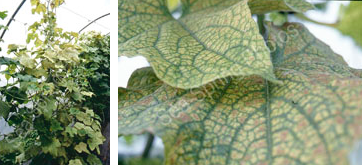
Red spider mite is the biggest pest problem with cucumbers grown in a tunnel or greenhouse.
A rotation programme may be needed to prevent the build-up of soil-borne diseases for plants grown in the ground. Mildew may also be a problem; it can be controlled by spraying or by growing varieties that have some resistance.
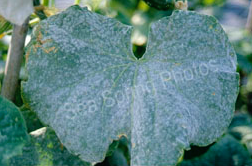
Powdery mildew may also be a problem with cucumbers.
Cucumbers are also prone to several viruses, spread by pests, by hand or by pruning knives. Affected plants are stunted with mottled leaves; they should be removed and destroyed to prevent infection of other plants.
Growing cucumbers outdoors
Although cucumbers like heat, there are some varieties worth trying outdoors in Britain, especially in southern England. Suitable varieties fall into so-called ‘slicing’ types – large fruit that can be eaten fresh – and smaller-fruited gherkin types, usually used for pickling. Unlike the all-female varieties grown indoors, those recommended for growing outdoors usually have male and female flowers on the same plants. These plants are insect pollinated, and produce fruit that contain seeds.
Like indoor cucumbers, outdoor crops should be started indoors and transplanted at the beginning of June in the south, but later further north or at higher elevations.
Plants can be grown in pots, growbags or in the ground. In the ground, space them 30cm apart, with 1.5–1.8 metres between rows. Vines can be allowed to grow over the ground like winter squashes, or trained up supports of netting, mesh or canes.
To get the most from your crop, harvest fruit when they are young and the seeds are still tender. Harvesting young also improves yields; fruit that get too large inhibit the production of more flowers and fruit.
 Enjoy more Kitchen Garden reading in the monthly magazine. Click here to subscribe.
Enjoy more Kitchen Garden reading in the monthly magazine. Click here to subscribe.
Sign-up to the Kitchen Garden Magazine Newsletter
Enter your e-mail address below to see a free digital back issue of Kitchen Garden Magazine and get regular updates straight to your inbox…
You can unsubscribe at any time.
About the Author
- The Cottage Garden Society ‘Grow In Pots’ For The Malvern Show 9-12 May - 12th April 2024
- Arundel Castle’s Tulip Festival returns - 7th February 2024
- FREE TREES FOR SCHOOLS - 4th January 2024









